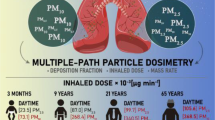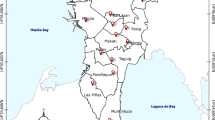Abstract
The increase in platinum (Pt) in the airborne particulate matter with size ≤2.5 µm (PM2.5) in urban environments may be interpreted as result of the abrasion and deterioration of automobile catalyst. Nowadays, about four million vehicles in Mexico City use catalytic converters, which means that their impact should be considered. In order to evaluate the contribution of Pt to environmental pollution of the metropolitan area of Mexico City (MAMC), airborne PM2.5 was collected at five different sites in the urban area (NW, NE, C, SW, SE) in 2011 during April (dry-warm season), August (rainy season) and December (dry-cold season). Analytical determinations were carried out using a ICP-MS with a collision cell and kinetic energy discrimination. The analytical and instrument performance was evaluated with standard road dust reference material (BCR-723). Median Pt concentration in the analyzed particulate was is 38.4 pg m−3 (minimal value 1 pg m−3 maximal value 79 pg m−3). Obtained Pt concentrations are higher than those reported for other urban areas. Spatial variation shows that SW had Pt concentration significantly higher than NW and C only. Seasonal variation shows that Pt median was higher in rainy season than in both dry seasons. A comparison of these results with previously reported data of PM10 from 1991 and 2003 in the same studied area shows a worrying increase in the concentration of Pt in the air environment of MAMC.


Similar content being viewed by others
References
Aldabe, J., Elustondo, D., Santamaría, C., Lasheras, E., Pandolfi, M., Alastuey, A., et al. (2011). Chemical characterization and source apportionment of PM2.5 and PM10 natural, urban and traffic sites in Navarra (North of Spain). Atmospheric Research, 102, 191–205.
Barbante, C., Veysseyre, A., Ferrari, C., Van de Velde, K., Morel, Ch., Capodagio, G., et al. (2001). Greenland snow evidence of large scale atmospheric contamination for platinum, palladium, and rhodium. Environmental Science Technology, 35, 835–839.
Bocca, B., Caimi, S., Smichowski, P., Gomez, D., & Caroli, S. (2006). Monitoring Pt and Rh in urban aerosols from Buenos Aires, Argentina. Science of the Total Environment, 358, 255–264.
Cheng, Y., Lee, S. C., Ho, K. F., Chow, J. C., Watson, J. G., Louie, P. K. K., et al. (2010). Chemically-speciated on-road PM2.5 motor vehicle emission factors in Hong Kong. Science of the Total Environment, 408, 1621–1627.
Duan, F. K., He, K. B., Ma, T. Y. L., Yang, F. M., Yu, X. C., Cadle, S. H., et al. (2006). Concentration and chemical characteristics of PM2.5 in Beijing, China: 2001–2002. Science of the Total Environment, 355, 264–275.
Ek, K. H., Morrison, G. M., & Rauch, S. (2004). Environmental routes for platinum group elements to biological materials: A review. Science of the Total Environment, 334–335, 21–38.
Federal Register (1987). Appendix J to Part 50—Reference method for the determination of particulate matter as PM10 in the atmosphere. National Primary and Secondary Air Quality Standards. http://www.ecfr.gov/cgi-bin/retrieveECFR?gp=&SID=afc7ddb450bdefa9a8a77be1bbf3610b&n=40y2.0.1.1.1&r=PART&ty=HTML#40:2.0.1.1.1.0.1.19.11 Accessed April 2014.
Gomez, B., Gomez, M., Sanchez, J. L., Fernandez, R., & Palacios, M. A. (2001). Platinum and rhodium distribution in airborne particulate matter and road dust. Science of the Total Environment, 269, 131–144.
Gomez, B., Palacios, M. A., Gomez, M., Sanchez, J. L., Morrison, G., Rauch, S., et al. (2002). Levels and risk assessment for humans and ecosystems of platinum-group elements in the airborne particles and road dust of some European cities. Science of the Total Environment, 299, 1–19.
He, K., Yang, F., Ma, Y., Zhang, Q., Yao, X., Chan, C. K., et al. (2001). The characteristics of PM25 in Beijing, China. Atmospheric Environment, 35, 4959–4970.
INECC, Instituto Nacional de Ecología y Cambio Climático (2012). Primer Catálogo de Estaciones de Monitoreo atmosférico en México. P 124. http://www2.inecc.gob.mx/publicaciones/consultaPublicacion.html?id_pub=681.
Jarvis, K. E., Parry, S., & Piper, J. M. (2001). Auto catalyst-derived platinum, rhodium, and palladium and selected vehicle-derived trace elements in the environment. Environmental Science Technology, 35, 1031–1036.
Kanitsar, K., Koellensperger, G., Hann, S., Limbeck, A., Puxbaum, H., & Stingeder, G. (2003). Determination of Pt, Pd and Rh by inductively coupled plasma sector field mass spectrometry (ICP-SFMS) in size-classified urban aerosol samples. Journal of Analitical Atomic Spectrometry, 18, 239–246.
Koppenaal, D. W., Eiden, G. C., & Barinaga, Ch J. (2004). Collision and reaction cells in atomic mass spectrometry: Development, status, and applications. Journal of Anlytical Atomic Spectrometry., 19, 561–570.
Kulshrestha, A., Gursumeeran Satsangi, P., Masih, J., & Taneja, A. (2009). Metal concentration of PM2.5 and PM10 particles and seasonal variations in urban and rural environment of Agra, India. Science of the Total Environment, 407, 6196–6204.
Limbeck, A., Puls, C., & Handler, M. (2007). Platinum and palladium emissions from on-road vehicles in the Kaisermühlen tunnel (Vienna, Austria). Environmental Science and Technology, 41, 4938–4945.
Marcazzan, G. M., Valli, G., & Vecchi, R. (2002). Factors influencing mass concentration and chemical composition of fine aerosols during a PM high pollution episode. Science of the Total Environment, 298, 65–79.
Morton-Bermea, O., Hernández-Álvarez, E., González-Hernández, G., Romero, F., Lozano, R., & Beramendi-Orosco, L. E. (2009). Assessment of heavy metal pollution in urban topsoils from the metropolitan area of Mexico City. Journal of Geochemical Exploration, 101, 218–224.
Niemelä, M., Perämäki, P., Piispanen, J., Poikolainen, J. (2004). Determination of platinum and rhodium in dust and plant samples using microwave-assisted sample digestion and ICP-MS. Analytica Chimica Acta, 521, 137–142.
Pope, C. A., Burnett, R. T., Thun, M. D., Calle, E. E., Krewski, D., Ito, K., et al. (2002). Lung cancer, cardiopulmonary mortality, and long-term exposure to fine particulate air pollution. Journal of American Medical Association, 287, 1132–1141.
Rauch, S., Hemond, H. F., Barmabte, C., Owari, M., Morrison, M., Peucker-Ehrenbrink, B., et al. (2005). Importance of automobile exhaust catalyst emissions for the deposition of platinum, palladium, and rhodium in the northern hemisphere. Environmental Science and Technology, 39, 8156–8162.
Rauch, S., Lu, M., & Morrison, G. (2001). Heterogeneity of platinum group metals in airborne particles. Environmental Science and Technology, 35, 595–599.
Rauch, S., Peucker-Ehrenbrink, B., Molina, L. T., Molina, M. J., Ramos, R., & Hemond, H. (2006). Platinumgroup elements in airborne particles in Mexico City. Environmental Science and Technology, 40, 7554–7560.
Ravindra, K., Bencs, L., & Van Grieken, R. (2004). Platinum group elements in the environment and their health risk. Science of the Total Environment, 318, 1–43.
Teixeira, E. C., Meira, L., de Ramos Santana, E. R., & Wiegand, F. (2009). Chemical composition of PM10 and PM2.5 and seasonal variation in south Brazil. Water, Air, and Soil pollution, 199, 261–275.
Wieseman, C. L. S., & Zereini, F. (2009). Airborne particulate matter, platinum group elements and human health: A review of recent evidence. Science of the Total Environment, 407, 2493–2500.
Zereini, F., Alsenz, H., Wiseman, C. L. S., Püttmann, W., Reimer, E., Schleyer, R., et al. (2012). Platinum group elements (Pt, Pd, Rh) in airborne particulate matter in rural versus urban areas of Germany: Concentrations and spatial patterns of distribution. Science of the Total Environment, 416, 261–268.
Zereini, F., Alt, F., Messerschmidt, J., von Bohlen, A., Liebl, K., & Püttmann, W. (2004). Concentration and distribution of platinum group elements (Pt, Pd, Rh) in airborne particulate matter in Frankfurt am Main, Germany. Environmental Science and Technology, 38, 1686–1692.
Zereini, F., Skerstupp, B., Alt, F., Helmers, E., & Urban, H. (1997). Geochemical behavior of platinum-group elements (PGE) in particulate emissions by automobile exhaust catalysts: Experimental results and environmental investigations. Science of the Total Environment, 206, 137–146.
Zereini, F., Wiseman, C., & Püttman, W. (2007). Changes in palladium, platinum, and rhodium concentrations, and their spatial distribution in soils along a major highway in Germany from 1994 to 2004. Environmental Science and Technology, 41, 451–456.
Zhao, X., Zhang, X., Xu, X., Xu, J., Wei, X., Meng, W., et al. (2009). Seasonal and diurnal variations of ambient PM2.5 concentration in urban and rural environments in Beijing. Atmospheric Environment, 43, 2893–2900.
Acknowledgments
This study was performed with financial support from DGAPA (Dirección General de Personal académico, UNAM) project IN101612 and CONACyT (Consejo Nacional de Ciencia y Tecnología) Project 166295.
Author information
Authors and Affiliations
Corresponding author
Rights and permissions
About this article
Cite this article
Morton-Bermea, O., Amador-Muñoz, O., Martínez-Trejo, L. et al. Platinum in PM2.5 of the metropolitan area of Mexico City. Environ Geochem Health 36, 987–994 (2014). https://doi.org/10.1007/s10653-014-9613-8
Received:
Accepted:
Published:
Issue Date:
DOI: https://doi.org/10.1007/s10653-014-9613-8




